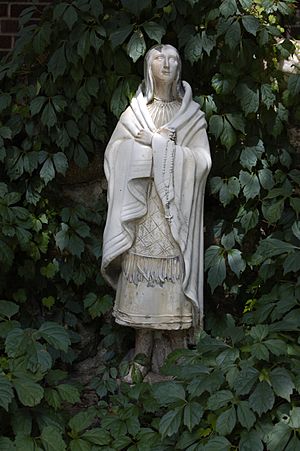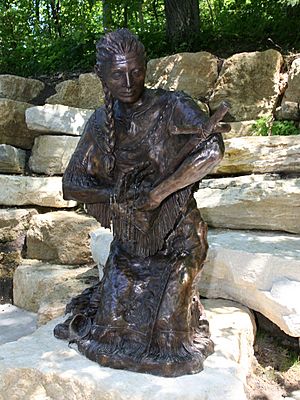Kateri Tekakwitha facts for kids
Quick facts for kids SaintKateri Tekakwitha |
|
|---|---|
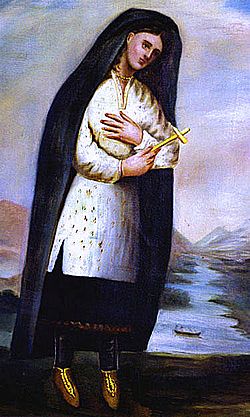
Portrait of Catherine Tekawitha, c. 1690, by Father Chauchetière
|
|
| Virgin | |
| Born | 1656 Ossernenon, New York |
| Baptized | 18 April 1676 |
| Died | 17 April 1680 (aged 24) Kahnawake (near Montreal), Quebec, Canada |
| Venerated in | Catholic Church |
| Beatified | 22 June 1980, Vatican City by Pope John Paul II |
| Canonized | 21 October 2012, Vatican City by Pope Benedict XVI |
| Major shrine | Saint Francis Xavier Church, Kahnawake, Quebec, Canada |
| Feast | 14 July 17 April (Canada) |
| Attributes | Lily; Turtle; Rosary |
| Patronage | ecologists, ecology, environment, environmentalists, loss of parents, people in exile, people ridiculed for their piety, Native Americans |
| Controversy | Pressure to marry against will, shunned for her Catholic beliefs |
Kateri Tekakwitha (born in 1656 – died April 17, 1680) was a Catholic saint and virgin. She was an Algonquin and Mohawk woman. Her Mohawk name, Tekakwitha, means "She who bumps into things." She was also known as the "Lily of the Mohawks."
Kateri was born in the Mohawk village of Ossernenon, in what is now New York State. When she was young, she got smallpox. This disease caused her family to die and left scars on her face. At age 19, she became a Catholic and was baptized with the Christian name Kateri, honoring Catherine of Siena.
Kateri decided not to marry. She left her village and moved to a Jesuit mission village called Kahnawake. This village was near Montreal, in what is now Canada. She lived there for the last five years of her life.
Kateri Tekakwitha promised to remain a virgin forever. When she died at age 24, people who were there said her scars disappeared. Her face looked bright and beautiful. She was known for being pure and for her strong faith. Some people in her tribe avoided her because she converted to Catholicism. She is the fourth Native American person to be honored as a saint in the Catholic Church.
Pope John Paul II declared her "blessed" in 1980. Then, Pope Benedict XVI made her a saint on October 21, 2012, at Saint Peter's Basilica. Many miracles and special events are believed to have happened because of her prayers.
Contents
Kateri's Early Life
Kateri Tekakwitha was born around 1656 in a Mohawk village called Ossernenon. This village was in what is now northeastern New York. Her mother was an Algonquin woman who had been captured and then became part of the Mohawk tribe. Her mother was Catholic and had learned about the faith from French missionaries. Kateri's father was a Mohawk chief. Kateri was their first child.
The Mohawk people often welcomed people from other tribes into their community. This helped them grow after many people died from wars or diseases.
Between 1661 and 1663, a serious smallpox outbreak hit the Mohawk villages. When Kateri was about four years old, her baby brother and both her parents died from smallpox. Kateri survived, but the disease left scars on her face and damaged her eyesight.
After her parents died, Kateri was adopted by her father's sister and her husband. They were a chief of the Turtle Clan. Kateri lived with her extended family in a longhouse. She learned important skills like making clothes from animal skins and weaving baskets. She also helped with planting and harvesting crops.
When Kateri was around 13, her family wanted her to marry. But she refused. She was a modest girl and often covered her face with a blanket because of her scars.
Changes and Challenges
Kateri grew up during a time of big changes for the Mohawk people. They were interacting with French and Dutch colonists. These colonists were competing to trade furs.
In 1666, the French attacked the Mohawk in New York. They burned three Mohawk villages and destroyed their homes and fields. Kateri, who was about ten years old, had to flee with her family into the cold forest.
After this defeat, the Mohawk had to agree to a peace treaty. This treaty meant they had to let Jesuit missionaries into their villages. The Jesuits learned the Mohawk language to share Christianity with the people. They used Mohawk words and ideas to help explain Christian beliefs.
The Mohawk rebuilt their village, Caughnawaga, on the north side of the river. In 1667, when Kateri was 11, she met Jesuit missionaries. Her uncle did not want her to have contact with them because he did not want her to become Christian.
In 1669, when Kateri was about 13, Mohican warriors attacked Caughnawaga. Kateri helped the priest Jean Pierron care for the wounded and bring food to the warriors defending the village. The Mohawk fought off the attackers.
Family and Faith
Around 1673, when Kateri was 17, her adoptive mother and aunt worried because she still didn't want to marry. They tried to arrange a marriage for her. But Kateri refused and even hid from her family. Her aunts tried to pressure her with harsh chores and teasing. But Kateri kept saying no to marriage. Eventually, her aunts stopped trying to make her marry.
In the spring of 1674, Kateri met a Jesuit priest named Jacques de Lamberville. Kateri had hurt her foot and was in the cabin while other women were harvesting corn. She told him she wanted to become a Christian. After this, she began to study the Christian faith with him.
Becoming a Christian
Father Lamberville wrote about Kateri after she died. He said she was a gentle girl who always tried to live a holy life. He noted that her desire to be holy sometimes caused small disagreements with others in her longhouse.
Father Lamberville felt Kateri was ready. He baptized her on April 18, 1676, when she was 19 years old. She was given the name "Catherine" (Kateri in Mohawk) after Saint Catherine of Siena.
After her baptism, Kateri stayed in Caughnawaga for six more months. Some Mohawks did not like her conversion and accused her of witchcraft. Father Lamberville suggested she move to the Jesuit mission of Kahnawake. This mission was south of Montreal and was home to other Native American converts. Kateri moved there in 1677.
Kateri was very devoted to her faith. She would sometimes put thorns on her sleeping mat to offer her suffering for her relatives' conversion. This was a way of showing deep prayer and sacrifice. She lived in Kahnawake for the last two years of her life. She learned more about Christianity from her mentor, Anastasia.
Father Cholonec wrote that Kateri said: "I have decided. My choice is made. I have given myself completely to Jesus, son of Mary. I have chosen Him as my husband, and He alone will take me as His wife."
The Church believes that Kateri's conversion was truly complete in 1679. She is seen as the "first Iroquois virgin" because of her strong commitment to purity.
Life at Kahnawake Mission
The Jesuits created Kahnawake as a mission village for Native Americans who converted to Catholicism. The people built traditional longhouses to live in. They also built a longhouse to be used as a chapel for the Jesuits.
When Kateri arrived, she lived in a longhouse with her older sister and her husband. She knew other people there who had moved from her old village. Anastasia Tegonhatsiongo, a close friend of Kateri's mother, was a leader in the longhouse. Anastasia and other Mohawk women helped Kateri learn about Christian practices.
The village of Kahnawake was set up like other Iroquois villages. It would move to new locations when natural resources like wood and game ran out. Many Native Americans from different tribes moved north to Kahnawake. The village was recognized by New France and had some freedom to manage its own affairs.
Jesuit priests Claude Chauchetière and Pierre Cholenec were important in Kateri's life. Both were based in Kahnawake. Chauchetière wrote the first story of Kateri's life. Cholenec arrived in New France before Chauchetière. He taught the converts at Kahnawake about Catholic ways of self-discipline.
Chauchetière was very impressed by Kateri's strong faith. He believed she was a saint. He wrote about her kindness, hard work, purity, and strength.
Kateri's Self-Discipline
Kateri believed that offering up suffering was valuable. She ate very little and sometimes added bad tastes to her food. She would lie on a mat with thorns. This was a way some Native American people showed thanks or offered prayers. She also burned herself slightly, thinking of how prisoners were treated. Her spiritual guide, Anastasia, seemed to encourage these practices.
Kateri's health was always poor, and these practices made her weaker. Her friend Marie-Thérèse asked Father Chauchetière for help. He told the young women that self-discipline must be done in moderation. He said they needed his approval for their practices so they wouldn't go too far. Kateri listened to the priest and only did what he allowed.
Friendship and Death
Kateri became good friends with Marie Thérèse Tegaianguenta when she arrived at Kahnawake. They often prayed together. The two women had a strong "spiritual friendship." They influenced others around them. They asked the Jesuits if they could form a group of native followers, but they were told they were "too young in faith." Still, the women continued to practice their faith together.
Around Holy Week in 1680, Kateri's friends noticed her health was getting worse. Villagers, along with priests Chauchetière and Cholenec, gathered as she was dying. Father Cholenec gave her the last rites. Kateri Tekakwitha died around 3 p.m. on April 17, 1680, at the age of 23 or 24. She died in the arms of her friend Marie-Thérèse. Chauchetière reported her last words were, "Jesus, Mary, I love you."
After her death, people saw a change in her appearance. Cholenec wrote that her scarred face suddenly became beautiful and white about 15 minutes after she died. Her smallpox scars were said to disappear.
Kateri is believed to have appeared to three people after her death: her mentor Anastasia, her friend Marie-Thérèse, and Father Chauchetière. Anastasia said she saw Kateri kneeling and holding a shining wooden cross. Marie-Thérèse said she heard Kateri's voice saying goodbye and that she was going to heaven. Chauchetière said he saw Kateri at her grave, looking toward heaven.
Chauchetière had a chapel built near Kateri's grave. By 1684, people started making pilgrimages there to honor her. The Jesuits later turned her bones into dust and placed the ashes in the rebuilt mission chapel. Her remains were sometimes used as relics for healing.
Kateri's Legacy
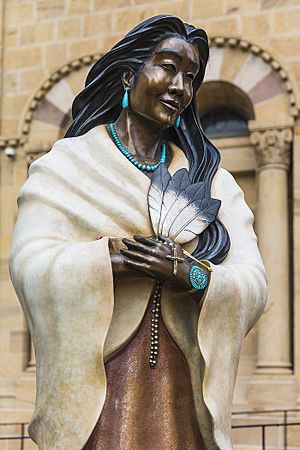
Kateri Tekakwitha's gravestone reads:
Kateri Tekakwitha
Ownkeonweke Katsitsiio Teonsitsianekaron
The fairest flower that ever bloomed among red men.
Kateri is often called a "lily," which is a symbol of purity. This is why religious pictures of her often show a lily and a cross. They also include feathers or a turtle, which are symbols of her Native American heritage. People also call her "The Lily of the Mohawks" or "The Pure and Tender Lily." Her good qualities are seen as a way to connect Mohawk and European cultures.
Honoring Kateri
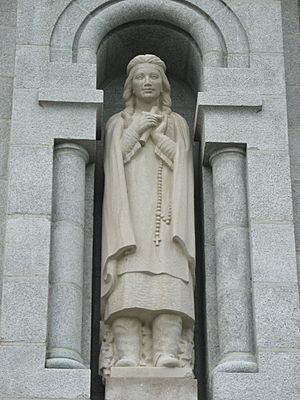
After her death, Kateri Tekakwitha was unofficially honored as a patroness of Montreal, Canada, and Indigenous peoples in the Americas. Fifty years later, a convent for Native American nuns opened in Mexico. They prayed for her to become a saint.
In the 1880s, Catholic missions and bishops in the US and Canada asked for Kateri Tekakwitha to be honored. They said she was pure and holy. Over 900 Native Americans signed letters asking for her to be made a saint.
On January 3, 1943, Pope Pius XII declared her "venerable." She was declared "blessed" by Pope John Paul II on June 22, 1980.
On December 19, 2011, Pope Benedict XVI approved a second miracle linked to Kateri. This paved the way for her to become a saint. On February 18, 2012, Pope Benedict XVI announced that Kateri would be canonized. She officially became a saint on October 21, 2012. She is the first Native American woman from North America to be made a saint by the Catholic Church.
In 2022, the Episcopal Church of the United States also approved a special day to honor Kateri on April 17.
Kateri Tekakwitha is honored at several national shrines in the United States. These include the National Shrine of Blessed Kateri Tekakwitha in Fonda, New York, and the National Shrine of the North American Martyrs in Auriesville, New York. Her habit of placing small wooden crosses in the woods inspired the design of The National Shrine of the Cross in the Woods in Michigan.
Statues of Saint Kateri are found in many places. One is outside the Basilica of Sainte-Anne-de-Beaupré in Quebec, Canada. Another is at the Cathedral Basilica of St. Francis of Assisi in Santa Fe, New Mexico.
In 2008, a bronze statue of Kateri kneeling in prayer was placed at the Shrine of Our Lady of Guadalupe in La Crosse, Wisconsin. The shrine sees Kateri as a special patron saint because she was a Native American and had a strong devotion to Mary through the Rosary.
- A life-size statue of Kateri is at the National Shrine Basilica of Our Lady of Fatima in Lewiston, New York.
- A bronze figure of Kateri is on the front doors of St. Patrick's Cathedral in New York City.
- The Maryknoll Sisters in Ossining, New York, have had a statue of Saint Kateri Tekakwitha since 1939.
- A statue of St. Kateri Tekakwitha was placed in the courtyard of St. Patrick's church in Pittsburgh, Pennsylvania.
- A garden section of the Holy Cross Chapel Mausoleum in North Arlington, New Jersey, is dedicated to Saint Kateri Tekakwitha. It has a life-size bronze statue of her releasing doves.
- A Place of Hope Shrine of St. Kateri is in Paris, Ohio.
- A larger-than-life statue of St. Kateri stands in St. Vincent de Paul Catholic Church in Rogers, Arkansas.
- A mosaic image of St. Kateri is on the wall of St. Mary of the Cataract Catholic Church in Niagara Falls, New York.
- A bronze statue by Kaye Guerin Marks is at Saint Kateri Tekakwitha Catholic Church in Sisseton, South Dakota.
- There is a bronze statue of St. Kateri at Saint Joseph Husband of Mary Catholic Church in Las Vegas, Nevada.
- There is a bronze statue of St. Kateri at the Immaculate Heart of Mary Catholic Church in Page, Arizona.
- There is a stained glass window of Kateri Tekakwitha in the Mary Queen of Peace chapel at the Church of Christ the King, Tulsa, Oklahoma.
Many churches, schools, and Catholic places are named after her. Examples include St. Kateri Tekakwitha Catholic Elementary Schools in Kitchener, Markham, and Hamilton, Ontario. Also, Saint Kateri Tekakwitha Catholic School in Orléans, Ottawa, and St. Kateri Tekakwitha School in Calgary, Alberta. In the United States, there are St. Kateri Tekakwitha Catholic Churches in Dearborn, Michigan, and Buffalo, Texas.
The St. Kateri Tekakwitha School in Niskayuna, New York, was named after her. The St. Kateri Tekakwitha Parish in Schenectady, New York, was formed by combining two churches. Kateri Residence, a nursing home in Manhattan, New York, is also named for her.
The St. Kateri Tekakwitha Church in Santa Clarita, California, has a statue of her. A statue of Saint Kateri Tekakwitha is at Holy Cross School at San Buenaventura Mission in southern California. This honors the local Native American Chumash people.
Kateri Tekakwitha is also honored at Camp Ondessonk, a Catholic youth camp in southern Illinois. One of the cabin units is named after her.
Since 1939, the Tekakwitha Conference has met every year to support Native Americans who are Catholic. At these conferences, people gather in "Kateri Circles" to pray.
The chapel of Welsh Family Hall at the University of Notre Dame is dedicated to Kateri Tekakwitha.
Tekakwitha Island (French: île Tekakwitha) in the St. Lawrence River, part of the Kahnawake reserve, is named after her.
On April 4, 2021, a Catholic Church in St. Theresa Point, Manitoba, Canada, burned down. The only things left were an almost untouched image of St. Kateri Tekakwitha and a statue of Mary.
In May 2021, a church built in St. Kateri's honor for the second time burned on the Bay Mills Indian Community in Michigan.
Miracles Attributed to Kateri
Many people believe that Kateri Tekakwitha has performed miracles. One story tells of Joseph Kellogg, a Protestant child who got smallpox in the 1700s. Doctors couldn't help him. A Jesuit priest told Joseph that if he became Catholic, he might get better. Joseph agreed. The priest gave him a piece of wood from Kateri's coffin, and Joseph is said to have healed. This shows that Kateri was believed to have healing powers even in the 18th century.
Other miracles were also linked to Kateri. Father Rémy got his hearing back, and a nun in Montreal was cured by using items that had belonged to Kateri. These events were seen as proof that Kateri might be a saint. People believed in her healing powers so much that some collected earth from her gravesite and wore it as a relic. One woman said she was saved from pneumonia after using a pendant with earth from Kateri's grave.
On December 19, 2011, Pope Benedict XVI approved the second miracle needed for Kateri to become a saint. This miracle happened in 2006. A young boy in Washington state had a very serious flesh-eating bacteria. Doctors could not stop the disease, and they told his parents he would likely die. The boy received a special prayer from a Catholic priest. Since the boy is half Lummi Indian, his parents prayed to Tekakwitha for help. A nun named Sister Kateri Mitchell visited the boy. She placed a small bone fragment (a relic) of Tekakwitha on his body and prayed with his parents. The next day, the infection stopped spreading.
Images for kids
See also
 In Spanish: Catalina Tekakwitha para niños
In Spanish: Catalina Tekakwitha para niños


